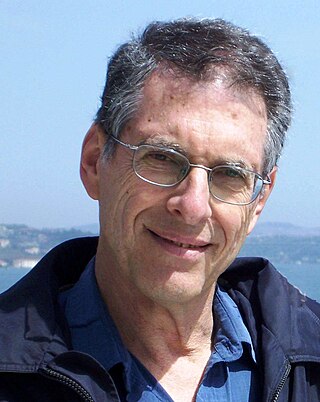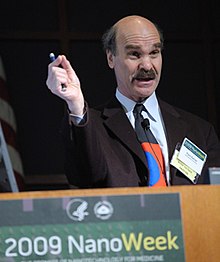Molecular electronics is the study and application of molecular building blocks for the fabrication of electronic components. It is an interdisciplinary area that spans physics, chemistry, and materials science. The unifying feature is use of molecular building blocks to fabricate electronic components. Due to the prospect of size reduction in electronics offered by molecular-level control of properties, molecular electronics has generated much excitement. It provides a potential means to extend Moore's Law beyond the foreseen limits of small-scale conventional silicon integrated circuits.

James Kazimierz Gimzewski FRS FREng FInstP is a Scottish physicist of Polish descent who pioneered research on electrical contacts with single atoms and molecules and light emission using scanning tunneling microscopy (STM).
The International Academy of Quantum Molecular Science (IAQMS) is an international scientific learned society covering all applications of quantum theory to chemistry and chemical physics. It was created in Menton in 1967. The founding members were Raymond Daudel, Per-Olov Löwdin, Robert G. Parr, John Pople and Bernard Pullman. Its foundation was supported by Louis de Broglie.

Sir James Fraser Stoddart is a British-American chemist who is Board of Trustees Professor of Chemistry and head of the Stoddart Mechanostereochemistry Group in the Department of Chemistry at Northwestern University in the United States. He works in the area of supramolecular chemistry and nanotechnology. Stoddart has developed highly efficient syntheses of mechanically-interlocked molecular architectures such as molecular Borromean rings, catenanes and rotaxanes utilising molecular recognition and molecular self-assembly processes. He has demonstrated that these topologies can be employed as molecular switches. His group has even applied these structures in the fabrication of nanoelectronic devices and nanoelectromechanical systems (NEMS). His efforts have been recognized by numerous awards including the 2007 King Faisal International Prize in Science. He shared the Nobel Prize in Chemistry together with Ben Feringa and Jean-Pierre Sauvage in 2016 for the design and synthesis of molecular machines.

The Journal of Physical Chemistry A is a scientific journal which reports research on the chemistry of molecules - including their dynamics, spectroscopy, kinetics, structure, bonding, and quantum chemistry. It is published weekly by the American Chemical Society.

Henry Frederick "Fritz" Schaefer III is a computational and theoretical chemist. He is one of the most highly cited chemists in the world, with a Thomson Reuters H-Index of 121 as of 2020. He is the Graham Perdue Professor of Chemistry and Director of the Center for Computational Chemistry at the University of Georgia. Before becoming professor at Georgia he was professor at University of California, Berkeley and in 2004, he became Professor of Chemistry Emeritus, at UC Berkeley
Nanoelectronics refers to the use of nanotechnology in electronic components. The term covers a diverse set of devices and materials, with the common characteristic that they are so small that inter-atomic interactions and quantum mechanical properties need to be studied extensively. Some of these candidates include: hybrid molecular/semiconductor electronics, one-dimensional nanotubes/nanowires or advanced molecular electronics.
James R. Heath is an American chemist and the president and professor of Institute of Systems Biology. Previous to this, he was the Elizabeth W. Gilloon Professor of Chemistry at the California Institute of Technology, after having moved from University of California Los Angeles.
The following outline is provided as an overview of and topical guide to nanotechnology:
Kizhakeyil Lukose Sebastian is a professor of chemistry at the department of Inorganic and Physical Chemistry of Indian Institute of Technology, Palakkad, India. Prior to becoming a professor at IIT Palakkad, he was a professor of chemistry at the department of Inorganic and Physical Chemistry at Indian Institute of Science, Bangalore, for about 20 years.
George Chappell Schatz, the Morrison Professor of Chemistry at Northwestern University, is a theoretical chemist best known for his seminal contributions to the field of reaction dynamics. Born in Watertown, New York, he obtained his B. S. from Clarkson University in 1971 and his Ph.D. from Caltech in 1976 under Aron Kuppermann. Following postdoctoral work at MIT, he joined the Chemistry Department at Northwestern University. Schatz is a member of the Center for Chemistry at the Space-Time Limit.
Molecular scale electronics, also called single-molecule electronics, is a branch of nanotechnology that uses single molecules, or nanoscale collections of single molecules, as electronic components. Because single molecules constitute the smallest stable structures imaginable, this miniaturization is the ultimate goal for shrinking electrical circuits.

Abraham Nitzan is a professor of chemistry at the Tel Aviv University department of chemical physics and the University of Pennsylvania department of chemistry.
Gustavo E. Scuseria is the Robert A. Welch Professor of Chemistry, Professor of Physics & Astronomy and Professor of Materials Science & NanoEngineering at Rice University, Houston, TX. He is also editor-in-chief of the Journal of Chemical Theory and Computation. Scuseria earned his PhD from the University of Buenos Aires in 1983 and conducted post-doctoral work at the University of California, Berkeley (1985-1987) and the University of Georgia (1987-1989) prior to joining the chemistry faculty at Rice University in 1989.
Michael Roman Wasielewski is an American physical chemist. He is currently the Clare Hamilton Hall Professor of Chemistry, director of the Center for Molecular Quantum Transduction (CMQT), and Executive Director of the Institute for Sustainability and Energy at Northwestern University.

Harold Basch was a professor of chemistry who specialized in computational chemistry.
Tamar Seideman is the Dow Chemical Company Professor of Chemistry and Professor of Physics at Northwestern University. She specialises in coherence spectroscopies and coherent control in isolated molecules and dissipative media as well as in ultrafast nanoplasmonics, current-driven phenomena in nanoelectronics and mathematical models.
Emily A. Weiss is the Mark and Nancy Ratner Professor of Chemistry and director of the Photo-Sciences Research Center at Northwestern University. Her research considers the optical and electronic properties of nanostructures, including hybrid organic–inorganic quantum dots. She was a two-time finalist in the Blavatnik Awards for Young Scientists.
This glossary of nanotechnology is a list of definitions of terms and concepts relevant to nanotechnology, its sub-disciplines, and related fields.
Gemma C. Solomon is an Australian chemist who is a professor at the Nanoscience Centre in the University of Copenhagen. She serves as Deputy Editor of ACS Physical Chemistry Au. Her research considers quantum interference and molecular electronics.






